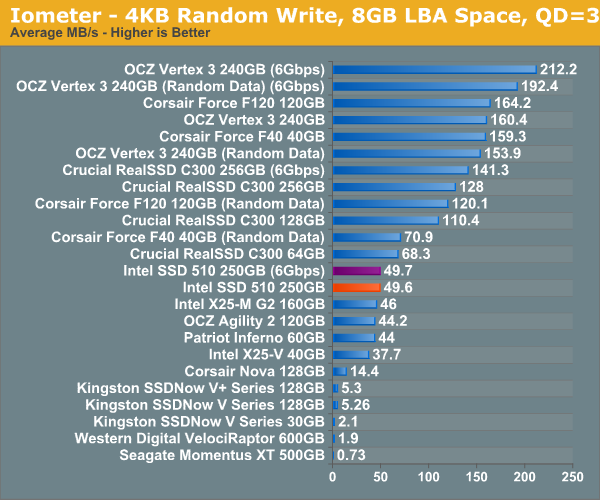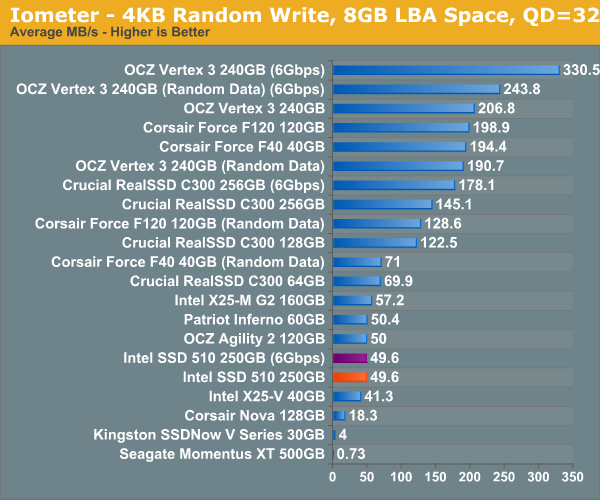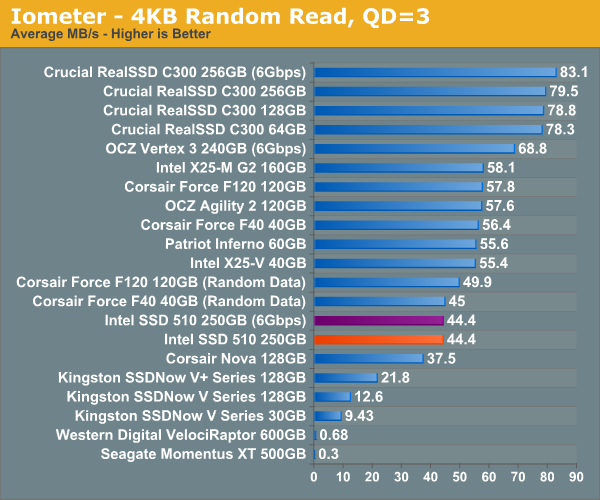The Intel SSD 510 Review
by Anand Lal Shimpi on March 2, 2011 1:23 AM EST- Posted in
- IT Computing
- Storage
- SSDs
- Intel
- Intel SSD 510
Random Read/Write Speed
The four corners of SSD performance are as follows: random read, random write, sequential read and sequential write speed. Random accesses are generally small in size, while sequential accesses tend to be larger and thus we have the four Iometer tests we use in all of our reviews.
Our first test writes 4KB in a completely random pattern over an 8GB space of the drive to simulate the sort of random access that you'd see on an OS drive (even this is more stressful than a normal desktop user would see). I perform three concurrent IOs and run the test for 3 minutes. The results reported are in average MB/s over the entire time. We use both standard pseudo randomly generated data for each write as well as fully random data to show you both the maximum and minimum performance offered by SandForce based drives in these tests. The average performance of SF drives will likely be somewhere in between the two values for each drive you see in the graphs. For an understanding of why this matters, read our original SandForce article.

It's a bit unfortunate for Intel that we happen to start our performance analysis with a 4KB random write test in Iometer. The 510's random write performance is only marginally better than the X25-M G2 at 49.7MB/s. The RealSSD C300 is faster, not to mention the SF-1200 based Corsair Force F120 and the SF-2200 based OCZ Vertex 3.
Although not depicted here, max write latency is significantly reduced compared to the X25-M G2. While the G2 would occasionally hit a ~900ms write operation, the 510 keeps the worst case latency to below 400ms. The Vertex 3 by comparison has a max write latency of anywhere from 60ms - 350ms depending on the type of data being written.
Many of you have asked for random write performance at higher queue depths. What I have below is our 4KB random write test performed at a queue depth of 32 instead of 3. While the vast majority of desktop usage models experience queue depths of 0 - 5, higher depths are possible in heavy I/O (and multi-user) workloads:

While the X25-M G2 scaled with queue depth in our random write test, the 510 does not. It looks like 50MB/s is the absolute highest performance we'll see for constrained 4KB random writes. Note that these numbers are for 4KB aligned transfers, performance actually drops down to ~40MB/s if you perform sector aligned transfers (e.g. performance under Windows XP).

Random read performance is just as disappointing. The X25-M G2 took random read performance seriously but the 510 is less than 20% faster than the Indilinx based Corsair Nova. When I said the Intel SSD 510's random performance is decidedly last-generation, I meant it.










128 Comments
View All Comments
TSnor - Wednesday, March 2, 2011 - link
Article says "Write speed with fully incompressible data is easily a victory for the SF-2200 based OCZ Vertex 3. "I think you meant "Write speed with compressible data is easily a victory for the SF-2200 based OCZ Vertex 3. "
Excellent article, I was interested in the 3rd gen intel SSD, but not at these specs. Wish you gave the read latency time (it can be inferred to some degree from the elapsed time charts which are good). Also, given the size of internal cache these devices use perhaps running for more than 3 mins would be a good idea. The average performance is still changing at 3 mins.
AstroGuardian - Wednesday, March 2, 2011 - link
"I mentioned earlier that the 510 would go through Intel’s extensive validation testing, just like any other Intel product."Yea right! Just like the H67 and P67. Yea, that made me so happy.
Anand Lal Shimpi - Wednesday, March 2, 2011 - link
That's 100% a valid point and it does show that even with extensive validation errors can still get through.You'll remember that the X25-M was the first to have major firmware issues before any of its present day competitors were even created.
Only time will tell how well Intel has learned from those experiences and how seriously it's taking the validation of the 510. Initial compatibility testing looks good but we've got a long road ahead of us.
Take care,
Anand
Ryomitomo - Thursday, March 3, 2011 - link
At least Intel's labs identified the problems themselves, disclosed the problem themselves, will recall and exchange to fix the problem.These things makes me feel very confident to buy future Intel products.
Nihility - Thursday, March 3, 2011 - link
A good point. Unlike certain NVIDIA mobile chipsets.Chloiber - Wednesday, March 2, 2011 - link
...I think Anand is right. Many of you are complaining, but as he said on the final page: it is not clear, where the actual limits are for random speeds. Of course, it's always better to have more. The thing is, that your PC at home can't benefit from 60'000 IOPS. It just can't. You can run it through benchmarks which show high numbers, but as soon as you feed the drive and the CPU with real data, the drive is NOT the limiting factor anymore.I'm not saying that it's a good thing the Intel 510 has such low random speeds, compared to other, even older drives. But in the end, the question is whether or not you can actually benefit from 200MB/s random reads and random writes with QDs above 4.
Anand said himself, and I assure you that he is correct - you can trace it yourself if you want - that with standard workload on home desktop PCs, Queue Depth rarely exceeds 1 or 2, especially not with an SSD in your system. Not even during boot!
And now THINK AGAIN. What are the random 4k read speeds for low QD of EVERY SSD today? It's actually limited by the NAND being used and it's between 20MB/s and 30MB/s for EVERY SSD.
Again, I'm not saying that high IOPS aren't important. I'm just saying, they aren't as important as you think. Not anymore, not in the very high regions we are today and especially not with very high QDs.
The 510 seems to have very good performance in real world benchmarks - it seems that most of you rate synthetic benchmarks higher than real world benchmarks. This, I don't quite understand.
semo - Wednesday, March 2, 2011 - link
The fact is, you will not be using a very competitively priced 250GB SSD for net browsing. When I get my SSD, I'll be using it to store my test VMs where I do a lot of software installations and snapshot jumping.The 510 is not a mainstream product where the QD rarely goes above 2. Not at that price at least. I've installed an SSD for a few average users but they were all 60GB drives. I could never justify the price of a 250GB SSD to them but a pro user might (i.e. someone who might make use of a high IOPS drive).
semo - Wednesday, March 2, 2011 - link
Meant to say "uncompetitively". Too expensive for the average computer user.tno - Thursday, March 3, 2011 - link
Spot on, and so a mainstream drive this is not. As workstation drive, however, this seems pretty solid.Nentor - Wednesday, March 2, 2011 - link
If it (the 510) was very cheap everything you say makes sense, but since it is not they'd better make it as fast as possible.